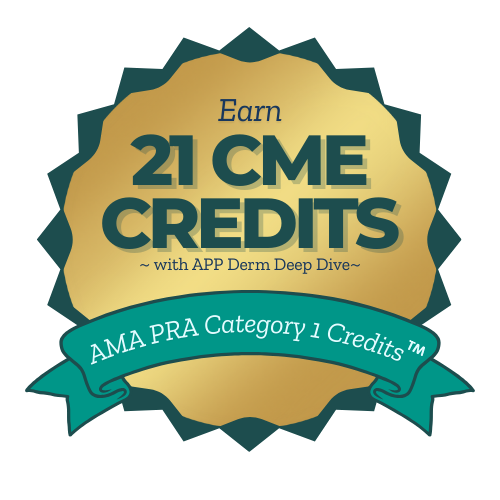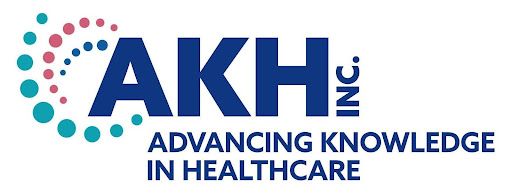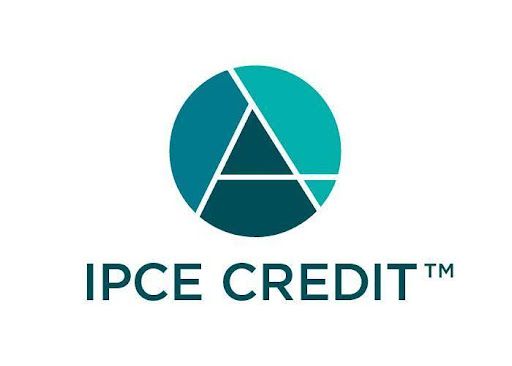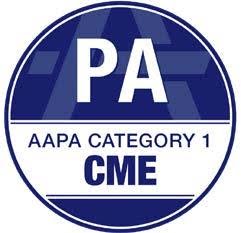APP Derm Deep Dive Course
The Expert Level
This tier offers specialized knowledge for experienced dermatology APPs. It dives deeper into complex dermatologic conditions, emerging therapies, and advanced treatment approaches, particularly for high-risk lesions, autoimmune disorders, and skin cancer management. This level is designed for APPs looking to refine their expertise and handle challenging cases with precision.
Key Features:
- 1800+ Clinical Images
- 12 Video Modules
- 17 hours of expert-led virtual training
- Module Exams to verify your mastery
- Learn emerging therapies, skin cancer management & advanced dermatologic conditions
AMA and AAPA Earn 21 hours of Continuing Medical Education (CME)
AANP Earn 21 contact hour(s) (which includes 3.0 hour(s) of pharmacology)
Write your awesome label here.

About the Derm Deep Dive Program
Results
Course Content
CME Overview
Activity Overview
This activity will help educate advanced practice and non-dermatology providers on accurately diagnosing dermatologic conditions.
Target Audience
This activity is designed for an audience of physicians, physician associates and nurse practitioners.
Learning Objectives
Upon completion of the educational activity, participants should be able to:
- Describe the importance of forming differential diagnosis
- Develop ability to properly diagnose through grouping of examination findings, termed categorization
- Organize Power Categories for common dermatologic conditions
- Implement differential diagnostic skills by using Power Categories
- Identify the primary lesions of acne
- Recognize the pathogenesis of acne
- Define the medications used in topical therapy
- Organize oral therapy options for acne
- Identify the side effects of common acne therapies
- Identify the clinical presentation of perioral dermatitis
- Describe the pathogenesis of acne rosacea
- Identify the fundamentals of topical therapy of acne rosacea
- Select oral therapy options for acne rosacea and acne vulgaris variants
- Identify the changes of steroid dermatitis
- Identify fundamental basics of diagnosis for actinic keratosis
- Describe risk factors for actinic keratosis
- Define clinical features of progression from actinic keratosis to squamous cell carcinoma
- Explain treatment options including long term analysis
- Describe Field Cancerization in review of the concept
- Define the basis for the term ‘ECZEMA’
- Identify types of eczematous dermatitis
- Discern etiologic and aggravating factors to atopic dermatitis
- Describe the immune components of atopic dermatitis
- Classify therapy and updated treatments
- Identify features of diagnosis for basal cell carcinoma
- Stratify risk factors for basal cell carcinoma
- Discuss treatment options including long term analysis
- Identify appropriate therapy based on subtype of tumor
- Recognize American Academy of Dermatology basal cell carcinoma treatment guidelines
- Discuss features of common benign growths
- Examine differential diagnosis for common skin conditions
- Describe unusual benign tumors
- Identify Blaschko’s lines presentation and contribution to epidermal nevi
- Determine risk of basal cell carcinoma in nevus sebaceous
- Identify key features in diagnosis of lichen planus
- Interpret scale, Wickham’s striae and color of lesions to aid in diagnosis
- Define potential etiologic agents of lichen planus
- Formulate a differential diagnosis for papulosquamous lesions
- Identify and understand significance of lichen sclerosis et atrophicus
- Identify primary lesion morphology of pityriasis rosea
- Discuss suspected causes of pityriasis rosea
- Expand knowledge of differential diagnosis through utilization of power categories
- Describe therapeutic options of pityriasis rosea
- Recognize clinical presentations for pityriasis lichenoides et varioliformis acuta
- Identify the type of lesions noted in psoriasis and seborrheic dermatitis
- Define the morphologic characteristics of primary lesions in the above diagnostic entities
- Organize the basic treatment parameters as well as some of more advanced therapeutic options
- Relate the associated general medical conditions associated with psoriasis and seborrheic dermatitis
- Describe fundamentals in the basics of diagnosis of squamous cell carcinoma
- Define risk factors for squamous cell carcinoma
- Identify clinical features of progression from actinic keratosis to squamous cell carcinoma
- Discuss treatment options including long term analysis
- Comprehend field cancerization in dermatology
- Identify primary lesion morphology of urticaria
- Describe the pathophysiology of urticaria
- Implement differential diagnosis formulation through utilization of power categories
- Recognize clinical factors which suggest a biopsy is indicated
- Define therapeutic options of urticaria
Criteria for Success
To obtain a certificate of completion, a score of 70% or better on the post-test is required. Please proceed with the activity until you have successfully completed this program, answered all test questions, completed the post-test and evaluation, and have received a digital copy of your certificate. You must participate in the entire activity to receive credit. If you have questions about this activity, please contact AKH Inc. at Ketrea@akhcme.com.





Disclosures
Commercial Support
There is no commercial support for this activity.
Relationships

Disclosures
It is the policy of AKH Inc. to ensure independence, balance, objectivity, scientific rigor, and integrity in all of its continuing education activities. The author must disclose to the participants any significant relationships with ineligible companies whose products or devices may be mentioned in the activity or with the commercial supporter of this continuing education activity. Identified conflicts of interest are mitigated by AKH prior to accreditation of the activity. AKH planners and reviewers have no relevant financial relationships to disclose.
Disclosure of Unlabeled
Use and Investigational Product. This educational activity may include discussion of uses of agents that are investigational and/or unapproved by the FDA. Please refer to the official prescribing information for each product for discussion of approved indications, contraindications, and warnings.
Disclaimer
This course is designed solely to provide the healthcare professional with information to assist in his/her practice and professional development and is not to be considered a diagnostic tool to replace professional advice or treatment. The course serves as a general guide to the healthcare professional, and therefore, cannot be considered as giving legal, nursing, medical, or other professional advice in specific cases. AKH Inc. specifically disclaim responsibility for any adverse consequences resulting directly or indirectly from information in the course, for undetected error, or through participant’s misunderstanding of the content.
If you would like to opt out from future communications from AKH please send an email to optout@akhcme.com with your information with "Opt Out" in the subject line.
